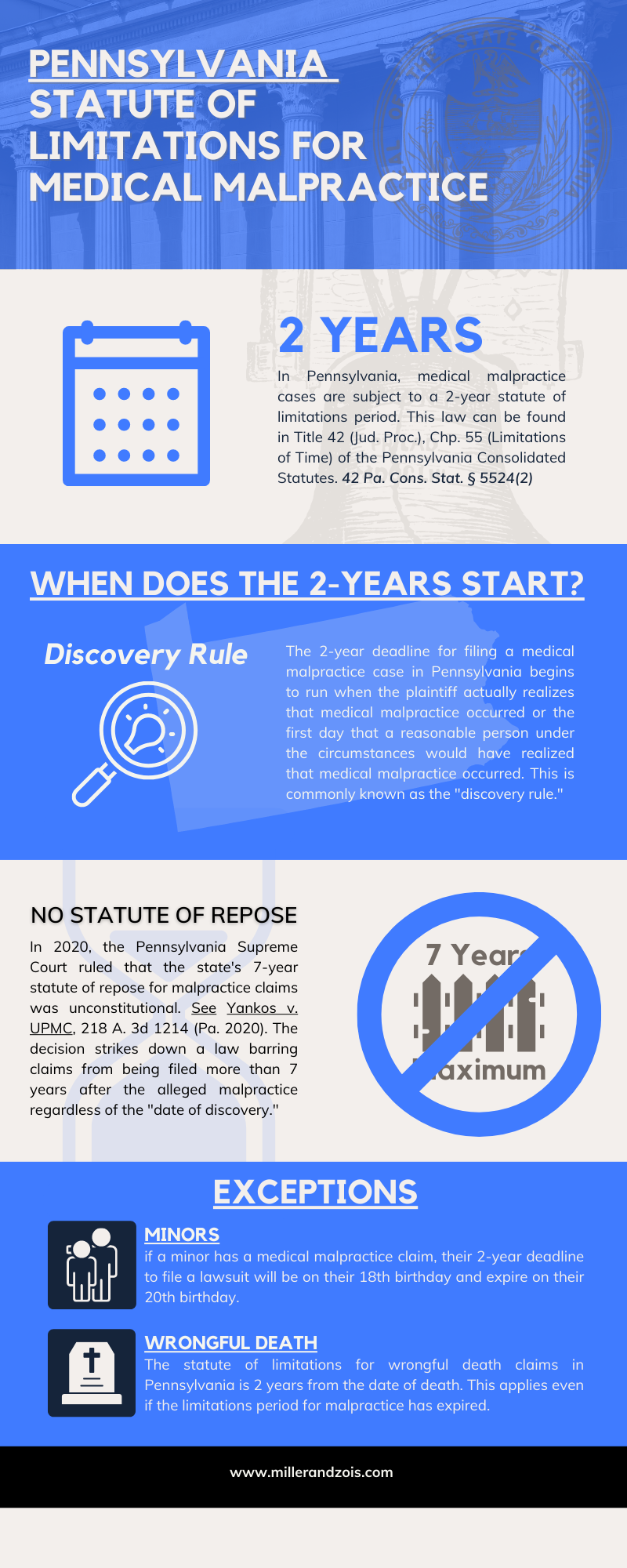Pennsylvania Statute of Limitations on Medical Malpractice
 All states have enacted laws that impose time limits on how long prospective plaintiffs can wait before filing a civil lawsuit against potential defendants. This type of time deadline for filing a lawsuit in Pennsylvania called a "statute of limitations." Different types of civil claims (e.g., negligence, malpractice, trespass, slander, etc.) are subject to different limitations deadlines.
All states have enacted laws that impose time limits on how long prospective plaintiffs can wait before filing a civil lawsuit against potential defendants. This type of time deadline for filing a lawsuit in Pennsylvania called a "statute of limitations." Different types of civil claims (e.g., negligence, malpractice, trespass, slander, etc.) are subject to different limitations deadlines.
The limitations deadline for filing a lawsuit for medical malpractice in Pennsylvania is two years from when the malpractice was first discovered or should have been discovered. This law can be found in Title 42 (Judicial Procedure), Chapter 55 (Limitations of Time) of the Pennsylvania Consolidated Statutes. 42 Pa. Cons. Stat. § 5524(2).
Pennsylvania Discovery Rule
Under the Pennsylvania discovery rule, the two years begins to run from the first day that a plaintiff actually realizes that medical malpractice occurred or the first day that a reasonable person under the circumstances would have realized that medical malpractice occurred.
The ostensible purpose of the discovery rule is to exclude the period during which the injured person is reasonably ignorant that she has sustained an injury. This puts innocent people who could not know they have a claim in the same position as someone who suffers an immediately ascertainable injury.
But the trigger for "you knew or should have known" rule is easily pulled so you don't want to wait and assume. So many victims do exactly that.
In a medical malpractice claim, the victim does not need to know the specific medical cause of an injury for the deadline to sue to begin to run. The statute of limitations will begin to run when the patient knows or should know that medical treatment has caused harm.
Pennsylvania courts will be quick to impose on the plaintiff the duty to use all reasonable diligence to become informed of the facts that form the foundation of a medical malpractice lawsuit in Pennsylvania. What might constitute a reasonable excuse in human terms is unlikely to be reasonable excuse to a Pennsylvania court trying to determine when the statute of limitations began to run.
Example Malpractice Statute of Limitations Scenario
Example: John has bypass surgery on his heart at a hospital in Philadelphia in 2017. After the procedure, everything seems to be fine for several years. However, 5 years later in 2022, John suffers a major heart attack and testing reveals that the 2017 bypass surgery was performed incorrectly and drastically increased his risk of heart attack.
Even though the actual malpractice occurred back in 2012, John had no way of knowing this until the error was discovered by subsequent testing in 2022. In this case, John's 2-year limitations starts running when the botched surgery was discovered in 2022. John has until 2024 to file his malpractice lawsuit.
7 Year Maximum (Malpractice Statute of Repose) The example above demonstrates how application of the "discovery rule" can potentially stretch out the limitation period for several years after the actual medical malpractice takes place.
The example above demonstrates how application of the "discovery rule" can potentially stretch out the limitation period for several years after the actual medical malpractice takes place.
But Pennsylvania passed the Medical Care Availability and Reduction of Error Act (MCARE). MCARE created a number of new laws designed to impose some constraints on medical malpractice litigation. One of these new constraints on medical malpractice claims was a "statute of repose" which effectively caps the maximum length of time for filing a malpractice claim regardless of when it is discovered. Under the Pennsylvania statute of repose, all lawsuits based on medical malpractice claims must be filed no more than 7 years after the alleged malpractice occurred regardless of when it was discovered.
Example: Continuing with the example above, let's say John had his heart surgery two years earlier in 2014. Everything seems fine for the first 8 years, then John has his subsequent heart attack in 2022. Testing reveals that the prior surgery was botched. In this fact scenario, John's malpractice claims for the botched 2014 surgery will be barred by the 7-year statute of repose.
There two significant exceptions to the 7-year max deadline under the statute of repose. First, the 7-year limit is not applicable to cases where a foreign object is mistakenly left inside the body during surgery. For example, if John had his heart surgery in 2014 and doctors accidentally left a sponge or surgical tool inside his chest, he does not have to sue within 7 years. Second, the statue of repose does not apply to claims of minors (i.e., individuals under the age of 18).
Special Rules for Malpractice Claims Made by MinorsWhen the prospective plaintiff in a medical malpractice lawsuit is a child (under the age of 18), neither the 2-year statute of limitations or the 7-year statute of repose deadlines apply. Unlike adults, minors are not expected to make decisions on whether to file a lawsuit for medical malpractice.
For this reason, Pennsylvania law "tolls" the application of the 2-year deadline until the minor reaches the age of majority (18). So if a minor has a medical malpractice claim, their 2-year deadline to file a lawsuit will be on their 18th birthday and expire on their 20th birthday.
Interpretation of the Discovery RuleApplication of the "discovery rules" is the most litigated aspect of Pennsylvania's statute of limitations in medical malpractice cases. Under the discovery rule, the 2-year deadline for a medical malpractice action does not begin until the time a plaintiff learns, or by the exercise of reasonable diligence could learn, of an injury potentially caused by medical error.
The discovery rule for malpractice lawsuits in Pennsylvania originated in cases in which the injury or its cause could not be known by the victim. So the purpose of the discovery rule is to stop the running of the statute of limitations that period "during which a party who has not suffered an immediately ascertainable injury is reasonably unaware he has been injured, so that he has essentially the same rights as those who have suffered such an injury.”
This doesn't mean that plaintiffs are expected to have expert medical knowledge or fully understand the nature of the medical negligence involved. Once the plaintiff becomes aware of the injury and the fact that it may have been caused by a doctor, the statute of limitations period begins to run.
Moreover, the 2-year deadline for how long you have to sue a doctor will begin to run when there are sufficient to prompt a reasonably diligent person to investigate.
For example, when a woman learns she has breast cancer it should immediately alert her that prior mammograms had been misread. So the statute of limitations would begin to run from the time she is first alerted to the fact that she had cancer, not the time that she confirms that prior mammograms were misread.
Consult With Miller & Zois About Pennsylvania Medical Malpractice ClaimsThe medical malpractice lawyers at Miller & Zois have represented hundreds of clients in successful medical malpractice cases. If you think you may have a medical malpractice case against a doctor or healthcare provider, it is very important that you act quickly. Because you have a very limited window of time.
The attorneys at Miller & Zois can advise you as to when your statute of limitations deadline will expire and make sure your case gets filed before that deadline. Call us 24 hours a day at 800-553-8082 or get a free online consultation.
Other Pennsylvania Malpractice Topics Miller & Zois, Attorneys at Law Home
Miller & Zois, Attorneys at Law Home











